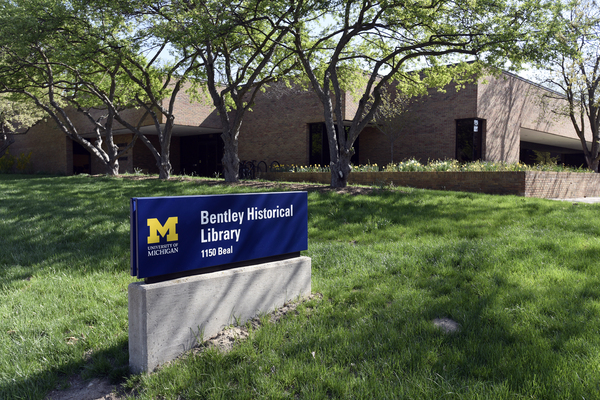Search Results
Correspondence, 1912-1968
26 linear feet
Correspondence (1912-1968; 26 linear ft.) is the largest series in the collection. The files are broken down into broad chronological subseries though there is frequent overlapping of dates depending upon whether an older file was carried over into a subsequent subseries because still of current use to Pollock or filing error. The researcher should consult the card index of Pollock correspondents if interested in a specific individual or organization. Also to be noted, this series includes more than correspondence. Depending upon the file heading, there could be reports, memoranda, and other kinds of documents. Correspondents include other political scientists, state government administrators, politicians, national figures, journalists, and those with whom he worked while stationed in Germany.
Correspondence, 1915-1951
3 linear feet
Correspondence (3 linear feet) is arranged chronologically (except for a scattering of special topic files) and covers the years 1915-1951. Correspondents include the major political and public figures of the day, including Dean Acheson, Thomas Dewey, John Foster Dulles, Herbert Hoover, Henry Cabot Lodge, Franklin D. Roosevelt, and Harry S. Truman. Researchers should note that the correspondence is but a fragment of what once existed. The files were severely weeded prior to their coming to the University of Michigan.
Correspondence and other Papers, 1879-1930
18.5 linear feet
The correspondence is arranged in strict chronological order according to the date of the letter received and the date of the reply to it. This means that the letter and its response are sometimes widely separated. However, the date of the reply was often noted on the incoming letter in blue pencil. Two indexes have been created to provide some access points to the chronological correspondence files.
A name index lists many of the most significant authors or recipients of letters. The alphabetical listing cites letters by the author by date. A second index provides access by broad topics and subjects. In the index notations, dates for original letters and responses are given. If the reply is in the same folder as the incoming letter, the dates in the index appear in order, separated by a comma. If the reply is in another folder, its notation is preceded by an R and the box, folder number, and date are given. Starting in 1913, copies of replies are sometimes on the back of the incoming letter itself so the researcher should check there also
President Hutchins continued the operation of the university as it had been under previous presidents, although with increasing expansion of course offerings and student numbers university management was beginning to become unwieldy. There was no organizational structure demarking administrative functions. This lack meant that a wide range of inquiries were addressed to the president -- including those regarding appointments, admissions, student financial aid, and medical care in the university hospitals. These were referred to the heads of the various departments and schools, to the secretary of the university, who oversaw financial affairs, or to the Student Christian Association, which arranged for student jobs.
An indication of how highly regarded the university was across the country may be found in the large number of inquiries from university or government officials in recently admitted states in the west where state systems of higher education were being developed. The range of topics on which they sought advice may be seen in the index listings under "Inquiries from other Educational Institutions".
Correspondence Files, 1900-1959
The CORRESPONDENCE series (11 linear feet, 1900-1903, 1929-1959) is arranged in four subseries: Correspondence, 1900-1903, 1929-1943; Director's Correspondence, 1946-1951; Editor's Correspondence, 1946-1951; and Director of University Relations Correspondence, 1950-1959. Most correspondence is with newspapers, magazine publishers, other universities, and radio and television broadcasting firms and associations.
The earliest correspondence, 1900-1903, includes letters written to Ralph Ellsworth relating to inquiries asking other universities about their information dissemination activities. Correspondence from 1929 to 1943 is chronologically arranged material sent and received by Roger Morrisey and Wilfred B. Shaw and reflects some of the alumni information activities once handled by the office as well as contact with press agencies and newspapers throughout Michigan and the nation
Director's Correspondence, 1946-1951, and Editor's Correspondence, 1946-1951, are similar in content. These two alphabetically arranged subseries comprise the correspondence of Arthur L. Brandon and Cleland B. Wyllie along with some other staff members. Wyllie served as editor but also handled other responsibilities within the office.
The most substantial subseries is the Director of University Relations Correspondence, 1950-1959, arranged alphabetically by topic. It is primarily the correspondence of Arthur L. Brandon. Topics include academic freedom and anti-communism activities (filed under "subversive activities"), the 250th anniversary of Detroit's founding, Harlan Hatcher's inauguration as president, controversy surrounding the renaming of Michigan State University, atomic research sponsored by the Phoenix Project, the 1955 Salk Polio vaccine testing and announcement, and radio and television broadcasting. General information on university activities and programs appears throughout the files, which also include scattered press releases, articles, and clippings in addition to the correspondence. Newspapers and magazines doing stories on the university, such as Life, are well represented within this subseries.
Correspondence (first accession), 1885-1931
The Van Tyne correspondence files were received in two separate accessions. The first includes material from 1885 to 1930 while the second spans the years 1901-1931.
